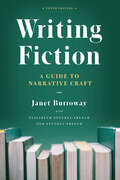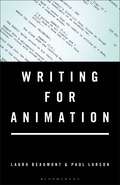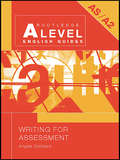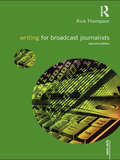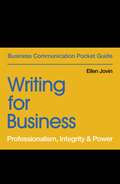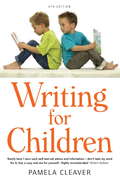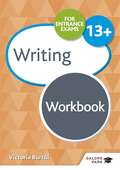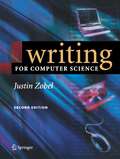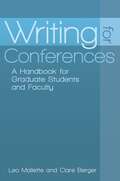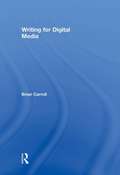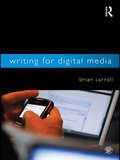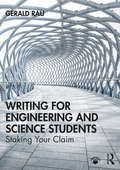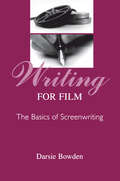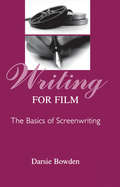- Table View
- List View
Writing Fiction, Tenth Edition: A Guide to Narrative Craft (Chicago Guides to Writing, Editing, and Publishing)
by Janet Burroway Elizabeth Stuckey-French Ned Stuckey-FrenchMore than 250,000 copies sold! A creative writer’s shelf should hold at least three essential books: a dictionary, a style guide, and Writing Fiction. Janet Burroway’s best-selling classic is the most widely used creative writing text in America, and for more than three decades it has helped hundreds of thousands of students learn the craft. Now in its tenth edition, Writing Fiction is more accessible than ever for writers of all levels—inside or outside the classroom. This new edition continues to provide advice that is practical, comprehensive, and flexible. Burroway’s tone is personal and nonprescriptive, welcoming learning writers into the community of practiced storytellers. Moving from freewriting to final revision, the book addresses “showing not telling,” characterization, dialogue, atmosphere, plot, imagery, and point of view. It includes new topics and writing prompts, and each chapter now ends with a list of recommended readings that exemplify the craft elements discussed, allowing for further study. And the examples and quotations throughout the book feature a wide and diverse range of today’s best and best-known creators of both novels and short stories. This book is a master class in creative writing that also calls on us to renew our love of storytelling and celebrate the skill of writing well. There is a very good chance that one of your favorite authors learned the craft with Writing Fiction. And who knows what future favorite will get her start reading this edition?
Writing Fiction, Tenth Edition: A Guide to Narrative Craft (Chicago Guides to Writing, Editing, and Publishing)
by Janet Burroway Elizabeth Stuckey-French Ned Stuckey-FrenchMore than 250,000 copies sold! A creative writer’s shelf should hold at least three essential books: a dictionary, a style guide, and Writing Fiction. Janet Burroway’s best-selling classic is the most widely used creative writing text in America, and for more than three decades it has helped hundreds of thousands of students learn the craft. Now in its tenth edition, Writing Fiction is more accessible than ever for writers of all levels—inside or outside the classroom. This new edition continues to provide advice that is practical, comprehensive, and flexible. Burroway’s tone is personal and nonprescriptive, welcoming learning writers into the community of practiced storytellers. Moving from freewriting to final revision, the book addresses “showing not telling,” characterization, dialogue, atmosphere, plot, imagery, and point of view. It includes new topics and writing prompts, and each chapter now ends with a list of recommended readings that exemplify the craft elements discussed, allowing for further study. And the examples and quotations throughout the book feature a wide and diverse range of today’s best and best-known creators of both novels and short stories. This book is a master class in creative writing that also calls on us to renew our love of storytelling and celebrate the skill of writing well. There is a very good chance that one of your favorite authors learned the craft with Writing Fiction. And who knows what future favorite will get her start reading this edition?
Writing Fiction, Tenth Edition: A Guide to Narrative Craft (Chicago Guides to Writing, Editing, and Publishing)
by Janet Burroway Elizabeth Stuckey-French Ned Stuckey-FrenchMore than 250,000 copies sold! A creative writer’s shelf should hold at least three essential books: a dictionary, a style guide, and Writing Fiction. Janet Burroway’s best-selling classic is the most widely used creative writing text in America, and for more than three decades it has helped hundreds of thousands of students learn the craft. Now in its tenth edition, Writing Fiction is more accessible than ever for writers of all levels—inside or outside the classroom. This new edition continues to provide advice that is practical, comprehensive, and flexible. Burroway’s tone is personal and nonprescriptive, welcoming learning writers into the community of practiced storytellers. Moving from freewriting to final revision, the book addresses “showing not telling,” characterization, dialogue, atmosphere, plot, imagery, and point of view. It includes new topics and writing prompts, and each chapter now ends with a list of recommended readings that exemplify the craft elements discussed, allowing for further study. And the examples and quotations throughout the book feature a wide and diverse range of today’s best and best-known creators of both novels and short stories. This book is a master class in creative writing that also calls on us to renew our love of storytelling and celebrate the skill of writing well. There is a very good chance that one of your favorite authors learned the craft with Writing Fiction. And who knows what future favorite will get her start reading this edition?
Writing Fiction, Tenth Edition: A Guide to Narrative Craft (Chicago Guides to Writing, Editing, and Publishing)
by Janet Burroway Elizabeth Stuckey-French Ned Stuckey-FrenchMore than 250,000 copies sold! A creative writer’s shelf should hold at least three essential books: a dictionary, a style guide, and Writing Fiction. Janet Burroway’s best-selling classic is the most widely used creative writing text in America, and for more than three decades it has helped hundreds of thousands of students learn the craft. Now in its tenth edition, Writing Fiction is more accessible than ever for writers of all levels—inside or outside the classroom. This new edition continues to provide advice that is practical, comprehensive, and flexible. Burroway’s tone is personal and nonprescriptive, welcoming learning writers into the community of practiced storytellers. Moving from freewriting to final revision, the book addresses “showing not telling,” characterization, dialogue, atmosphere, plot, imagery, and point of view. It includes new topics and writing prompts, and each chapter now ends with a list of recommended readings that exemplify the craft elements discussed, allowing for further study. And the examples and quotations throughout the book feature a wide and diverse range of today’s best and best-known creators of both novels and short stories. This book is a master class in creative writing that also calls on us to renew our love of storytelling and celebrate the skill of writing well. There is a very good chance that one of your favorite authors learned the craft with Writing Fiction. And who knows what future favorite will get her start reading this edition?
Writing Fiction, Tenth Edition: A Guide to Narrative Craft (Chicago Guides to Writing, Editing, and Publishing)
by Janet Burroway Elizabeth Stuckey-French Ned Stuckey-FrenchMore than 250,000 copies sold! A creative writer’s shelf should hold at least three essential books: a dictionary, a style guide, and Writing Fiction. Janet Burroway’s best-selling classic is the most widely used creative writing text in America, and for more than three decades it has helped hundreds of thousands of students learn the craft. Now in its tenth edition, Writing Fiction is more accessible than ever for writers of all levels—inside or outside the classroom. This new edition continues to provide advice that is practical, comprehensive, and flexible. Burroway’s tone is personal and nonprescriptive, welcoming learning writers into the community of practiced storytellers. Moving from freewriting to final revision, the book addresses “showing not telling,” characterization, dialogue, atmosphere, plot, imagery, and point of view. It includes new topics and writing prompts, and each chapter now ends with a list of recommended readings that exemplify the craft elements discussed, allowing for further study. And the examples and quotations throughout the book feature a wide and diverse range of today’s best and best-known creators of both novels and short stories. This book is a master class in creative writing that also calls on us to renew our love of storytelling and celebrate the skill of writing well. There is a very good chance that one of your favorite authors learned the craft with Writing Fiction. And who knows what future favorite will get her start reading this edition?
Writing for Animation
by Laura Beaumont Paul LarsonAnimation is one of the fastest growing mediums in the film and television world – whether it's Frozen or Paw Patrol, Family Guy or Rick and Morty. This book is the definitive guide to storytelling for writers, directors, storyboard artists and animators. Suitable for both the student and the professional, it provides indispensable knowledge on the entire process of writing for animated movies, TV series and short films. The reader will be provided with all the tools necessary to produce professional quality scripts that will start, or further, their career in animation. Beginning with the fundamentals of 'why animation?' this book will lead the reader through a series of principles that will raise the level of their storytelling. These principles are tried and tested on a daily basis by the authors who have a twenty-year track record in the animation industry.Many people are trying to break into the world of writing for animation and a lot of the people who are 'already in' would like to get more work. The reality is that writing for animation is a very specific craft that can be learnt like any other craft. This book will give the reader both the basic and advanced techniques that will put them ahead of the rest of the field.
Writing for Animation
by Laura Beaumont Paul LarsonAnimation is one of the fastest growing mediums in the film and television world – whether it's Frozen or Paw Patrol, Family Guy or Rick and Morty. This book is the definitive guide to storytelling for writers, directors, storyboard artists and animators. Suitable for both the student and the professional, it provides indispensable knowledge on the entire process of writing for animated movies, TV series and short films. The reader will be provided with all the tools necessary to produce professional quality scripts that will start, or further, their career in animation. Beginning with the fundamentals of 'why animation?' this book will lead the reader through a series of principles that will raise the level of their storytelling. These principles are tried and tested on a daily basis by the authors who have a twenty-year track record in the animation industry.Many people are trying to break into the world of writing for animation and a lot of the people who are 'already in' would like to get more work. The reality is that writing for animation is a very specific craft that can be learnt like any other craft. This book will give the reader both the basic and advanced techniques that will put them ahead of the rest of the field.
Writing for Assessment (Routledge A Level English Guides)
by Angela GoddardThis text helps students to develop the writing skills they need to succeed in AS and A2 level English; offers a step-by-step guide to approaching writing tasks and structuring a response; looks at a range of writing tasks, from argumentative essays to data-based investigations; provides Personal Audit Sheets (PASS) to help students assess their own writing skills and make practical steps to develop them; can be used as preparation for both coursework and exams.Written by an experienced teacher, author and AS and A2 level examiner, Writing for Assessment is an essential resource for all students of AS and A2 level English Language, English Literature, and English Language and Literature
Writing for Assessment (Routledge A Level English Guides)
by Angela GoddardThis text helps students to develop the writing skills they need to succeed in AS and A2 level English; offers a step-by-step guide to approaching writing tasks and structuring a response; looks at a range of writing tasks, from argumentative essays to data-based investigations; provides Personal Audit Sheets (PASS) to help students assess their own writing skills and make practical steps to develop them; can be used as preparation for both coursework and exams.Written by an experienced teacher, author and AS and A2 level examiner, Writing for Assessment is an essential resource for all students of AS and A2 level English Language, English Literature, and English Language and Literature
Writing for Broadcast Journalists (Media Skills)
by Rick Thompson'This is a superb book which combines the rare mixture of high quality information with humour. The style of writing engages the reader from the introduction and the experience and insight of the author occasionally makes it difficult to put down, a rare feature of a textbook. I would unreservedly recommend this book not only to those studying journalism but to students of language and all who use the spoken and written word as the ‘materials’ of their work.' Barry Turner, Nottingham Trent University 'Rick Thompson's guidance manual is packed with advice to would-be writers for this medium. He's someone with years of experience at the top level of the national and international profession, and he's smack up to date with his references. The book is aimed at journalists, but anyone with a serious interest in developing their literacy will learn a lot about professional writing skills from what he has to say.' Roy Johnson, www.mantex.co.uk Writing for Broadcast Journalists guides readers through the significant differences between the written and the spoken versions of journalistic English. It will help broadcast journalists at every stage of their careers to avoid such pitfalls as the use of newspaper-English, common linguistic errors, and Americanised phrases, and gives practical advice on accurate terminology and pronunciation, while encouraging writers to capture the immediacy of the spoken word in their scripts. Writing for Broadcast Journalists includes: practical tips on how to avoid ‘journalese’, clichés and jargon guidance on tailoring your writing style to suit a particular audience advice on converting agency copy into spoken English writing to television pictures examples of scripts from some of the best in the business an appendix of ‘dangerous’ words and phrases to be avoided in scripts.
Writing for Broadcast Journalists (Media Skills)
by Rick Thompson'This is a superb book which combines the rare mixture of high quality information with humour. The style of writing engages the reader from the introduction and the experience and insight of the author occasionally makes it difficult to put down, a rare feature of a textbook. I would unreservedly recommend this book not only to those studying journalism but to students of language and all who use the spoken and written word as the ‘materials’ of their work.' Barry Turner, Nottingham Trent University 'Rick Thompson's guidance manual is packed with advice to would-be writers for this medium. He's someone with years of experience at the top level of the national and international profession, and he's smack up to date with his references. The book is aimed at journalists, but anyone with a serious interest in developing their literacy will learn a lot about professional writing skills from what he has to say.' Roy Johnson, www.mantex.co.uk Writing for Broadcast Journalists guides readers through the significant differences between the written and the spoken versions of journalistic English. It will help broadcast journalists at every stage of their careers to avoid such pitfalls as the use of newspaper-English, common linguistic errors, and Americanised phrases, and gives practical advice on accurate terminology and pronunciation, while encouraging writers to capture the immediacy of the spoken word in their scripts. Writing for Broadcast Journalists includes: practical tips on how to avoid ‘journalese’, clichés and jargon guidance on tailoring your writing style to suit a particular audience advice on converting agency copy into spoken English writing to television pictures examples of scripts from some of the best in the business an appendix of ‘dangerous’ words and phrases to be avoided in scripts.
Writing for Business: Professionalism, Integrity & Power (Business Communication Pocket Guides)
by Ellen JovinBuild essential skills and write with confidence at work! Immediately practical guide to better business writing designed to help you develop a clear, direct, natural communication style that supports rather than obscures what you want to say. Writing for Business covers writing principles that are relevant for a wide range of business documents, including email, letters, memos, reports, proposals, and more, while also offering editing tips to ensure you come across as professional and polished. The book features examples and tips straight from the workplace.
Writing For Children, 4th Edition: How To Write For Children And Get Published
by Pamela CleaverThis new edition combines Pamela Cleaver's bestselling Writing a Children's Book with her Ideas for Children's Writers. In it you will learn about plotting and planning, beginnings, middles and endings, how to research and how to revise and how to find a publisher. There are: * Lists of attributes to help you create interesting and believable characters * Lists of plots and themes * Genres - what's hot and what's not * Locations and how much description to use * List of do's and don'ts regarding submitting manuscripts * Symbols for correcting your proofs * Tips on how to publicise your book. There is no one right way to write a children's book but if you are armed with a knowledge of certain techniques that have worked for other writers you will be more likely to succeed.Contents: Acknowledgements; Introduction; 1. Limbering Up; 2. Plotting; 3. Story People: the Characters in Your Book; 4. Genres; 5. Where and When?; 6. Starting the Story; 7. Telling the Tale; 8. Writing for the Younger Set; 9. Happy Ever After?; 10. Research and Revision; 11. Writing a Non-Fiction Book; 12. Getting Published; 13. If Your Book is Accepted; 14. If Your Book is Rejected; Useful Information for Writing Children's Book; Index.
Writing for Common Entrance 13+ Workbook (PDF)
by Victoria Burrill£10.99 7 Used from £8.71 18 New from £9.50 Exam Board: ISEB Level: 13+ Subject: English First Teaching: September 2012 First Exam: Autumn 2013 Please note this workbook is also suitable for the new ISEB CE 13+ specification for first teaching from September 2021 and for first exams from November 2022. Ensure success in 13+ exams with this skills-based writing workbook. This write-in workbook covers the skills required to generate written pieces in the specified range of non-fiction text types, and provides the tools needed to make creative writing original and interesting. - Develops the writing skills needed to do well in ISEB Common Entrance, CASE and other 13+ exams - Enables students to use written language effectively, for creative expression and practical communication, through engaging activities - Breaks down content into digestible writing and planning tasks, and includes past paper questions grouped by task and by topic - Offers extension tasks that stretch students to practise higher-order writing and research skills - Provides opportunities for independent study and home-based revision and practice
Writing for Computer Science
by Justin ZobelA complete update to a classic, respected resource Invaluable reference, supplying a comprehensive overview on how to undertake and present research
Writing for Conferences: A Handbook for Graduate Students and Faculty
by Leo A. Mallette Clare BergerThis book answers every question a doctoral graduate new to publishing could have about writing for a conference, from "Why would I want to publish at a conference?" to "What do I wear?"Conferences are often a researcher's first foray into publishing. Each year, about 50,000 new doctoral graduates arrive to the publishing landscape, most with little or no understanding of how the conference publication process works. Yet until now, there have been no publications devoted to this specific subject.Writing for Conferences: A Handbook for Graduate Students and Faculty serves as an essential guide for graduate students who want to publish the results of the research projects of their graduate program to maximum effect. It explains the conference publication process step-by-step and answers all of the questions asked by students inexperienced in publishing. The book is also a valuable reference manual for previously published authors, providing insightful sections on ethics in publishing, dress and grooming, presentation tips, and networking techniques to develop further research and career opportunities.
Writing for Digital Media
by Brian CarrollThis work teaches students how to write effectively for online audiences while providing them with a solid understanding of the ways that the Internet has blurred traditional roles of media producer, consumer, publisher, and reader. 9780415992015 9780203894316
Writing for Digital Media
by Brian CarrollWriting for Digital Media teaches students how to write effectively for online audiences—whether they are crafting a story for the website of a daily newspaper or a personal blog. The lessons and exercises in each chapter help students build a solid understanding of the ways that the Internet has introduced new opportunities for dynamic storytelling as digital media have blurred roles of media producer, consumer, publisher and reader. Using the tools and strategies discussed in this book, students are able to use their insights into new media audiences to produce better content for digital formats and environments. Fundamentally, this book is about good writing—clear, precise, accurate, filled with energy and voice, and aimed directly at an audience. Writing for Digital Media also addresses all of the graphical, multimedia, hypertextual and interactive elements that come into play when writing for digital platforms. Learning how to achieve balance and a careful, deliberate blend of these elements is the other primary goal of this text. Writing for Digital Media teaches students not only how to create content as writers, but also how to think critically as a site manager or content developer might about issues such as graphic design, site architecture, and editorial consistency. By teaching these new skill sets alongside writing fundamentals, this book transforms students from writers who are simply able to post their stories online into engaging multimedia, digital storytellers. For additional resources and exercises, visit the Companion Website for Writing for Digital Media at: www.routledge.com/textbooks/9780415992015.
Writing for Digital Media
by Brian CarrollWriting for Digital Media teaches students how to write effectively for online audiences—whether they are crafting a story for the website of a daily newspaper or a personal blog. The lessons and exercises in each chapter help students build a solid understanding of the ways that the Internet has introduced new opportunities for dynamic storytelling as digital media have blurred roles of media producer, consumer, publisher and reader. Using the tools and strategies discussed in this book, students are able to use their insights into new media audiences to produce better content for digital formats and environments. Fundamentally, this book is about good writing—clear, precise, accurate, filled with energy and voice, and aimed directly at an audience. Writing for Digital Media also addresses all of the graphical, multimedia, hypertextual and interactive elements that come into play when writing for digital platforms. Learning how to achieve balance and a careful, deliberate blend of these elements is the other primary goal of this text. Writing for Digital Media teaches students not only how to create content as writers, but also how to think critically as a site manager or content developer might about issues such as graphic design, site architecture, and editorial consistency. By teaching these new skill sets alongside writing fundamentals, this book transforms students from writers who are simply able to post their stories online into engaging multimedia, digital storytellers. For additional resources and exercises, visit the Companion Website for Writing for Digital Media at: www.routledge.com/textbooks/9780415992015.
Writing for Digital Media (PDF)
by Brian CarrollThis work teaches students how to write effectively for online audiences while providing them with a solid understanding of the ways that the Internet has blurred traditional roles of media producer, consumer, publisher, and reader. 9780415992015 9780203894316
Writing for Engineering and Science Students: Staking Your Claim
by Gerald RauWriting for Engineering and Science Students is a clear and practical guide for anyone undertaking either academic or technical writing. Drawing on the author’s extensive experience of teaching students from different fields and cultures, and designed to be accessible to both international students and native speakers of English, this book: Employs analyses of hundreds of articles from engineering and science journals to explore all the distinctive characteristics of a research paper, including organization, length and naming of sections, and location and purpose of citations and graphics; Guides the student through university-level writing and beyond, covering lab reports, research proposals, dissertations, poster presentations, industry reports, emails, and job applications; Explains what to consider before and after undertaking academic or technical writing, including focusing on differences between genres in goal, audience, and criteria for acceptance and rewriting; Features tasks, hints, and tips for teachers and students at the end of each chapter, as well as accompanying eResources offering additional exercises and answer keys. With metaphors and anecdotes from the author’s personal experience, as well as quotes from famous writers to make the text engaging and accessible, this book is essential reading for all students of science and engineering who are taking a course in writing or seeking a resource to aid their writing assignments.
Writing for Engineering and Science Students: Staking Your Claim
by Gerald RauWriting for Engineering and Science Students is a clear and practical guide for anyone undertaking either academic or technical writing. Drawing on the author’s extensive experience of teaching students from different fields and cultures, and designed to be accessible to both international students and native speakers of English, this book: Employs analyses of hundreds of articles from engineering and science journals to explore all the distinctive characteristics of a research paper, including organization, length and naming of sections, and location and purpose of citations and graphics; Guides the student through university-level writing and beyond, covering lab reports, research proposals, dissertations, poster presentations, industry reports, emails, and job applications; Explains what to consider before and after undertaking academic or technical writing, including focusing on differences between genres in goal, audience, and criteria for acceptance and rewriting; Features tasks, hints, and tips for teachers and students at the end of each chapter, as well as accompanying eResources offering additional exercises and answer keys. With metaphors and anecdotes from the author’s personal experience, as well as quotes from famous writers to make the text engaging and accessible, this book is essential reading for all students of science and engineering who are taking a course in writing or seeking a resource to aid their writing assignments.
Writing for Film: The Basics of Screenwriting
by Darsie BowdenIn this introduction to screenwriting, author Darsie Bowden provides sage, real-world advice and instruction on the process of writing film screenplays. This text will help budding screenwriters to structure their dramas, refine their characterizations, and craft their language, while also introducing them to the appropriate screenplay formats. It covers the complexities of writing for the screen and points out the contradictions to expect if readers pursue this work as a career. In addition to covering the elements of the dramatic film screenplay, Bowden discusses writing for such "alternative" markets as documentaries, independent films, experimental films, and other non-Hollywood options. Features of the text include:guidelines for working as a screenwriter;applications and exercises to enhance skills;suggested readings for further development; anda comprehensive list of resources for screenwriting.Successful writing for film lies in being able to heighten one's perceptive abilities about the world and to communicate those perceptions in a cinematic way. In this text, Bowden introduces readers to an approach to screenwriting that will help them see the world in a different way and write about it using different genres and media. This most valuable skill prepares readers for the range of possibilities they will encounter on the path to successful screenwriting.
Writing for Film: The Basics of Screenwriting
by Darsie BowdenIn this introduction to screenwriting, author Darsie Bowden provides sage, real-world advice and instruction on the process of writing film screenplays. This text will help budding screenwriters to structure their dramas, refine their characterizations, and craft their language, while also introducing them to the appropriate screenplay formats. It covers the complexities of writing for the screen and points out the contradictions to expect if readers pursue this work as a career. In addition to covering the elements of the dramatic film screenplay, Bowden discusses writing for such "alternative" markets as documentaries, independent films, experimental films, and other non-Hollywood options. Features of the text include:guidelines for working as a screenwriter;applications and exercises to enhance skills;suggested readings for further development; anda comprehensive list of resources for screenwriting.Successful writing for film lies in being able to heighten one's perceptive abilities about the world and to communicate those perceptions in a cinematic way. In this text, Bowden introduces readers to an approach to screenwriting that will help them see the world in a different way and write about it using different genres and media. This most valuable skill prepares readers for the range of possibilities they will encounter on the path to successful screenwriting.
Writing for Film: The Basics of Screenwriting
by Darsie BowdenIn this introduction to screenwriting, author Darsie Bowden provides sage, real-world advice and instruction on the process of writing film screenplays. This text will help budding screenwriters to structure their dramas, refine their characterizations, and craft their language, while also introducing them to the appropriate screenplay formats. It covers the complexities of writing for the screen and points out the contradictions to expect if readers pursue this work as a career. In addition to covering the elements of the dramatic film screenplay, Bowden discusses writing for such "alternative" markets as documentaries, independent films, experimental films, and other non-Hollywood options. Features of the text include:guidelines for working as a screenwriter;applications and exercises to enhance skills;suggested readings for further development; anda comprehensive list of resources for screenwriting.Successful writing for film lies in being able to heighten one's perceptive abilities about the world and to communicate those perceptions in a cinematic way. In this text, Bowden introduces readers to an approach to screenwriting that will help them see the world in a different way and write about it using different genres and media. This most valuable skill prepares readers for the range of possibilities they will encounter on the path to successful screenwriting.
